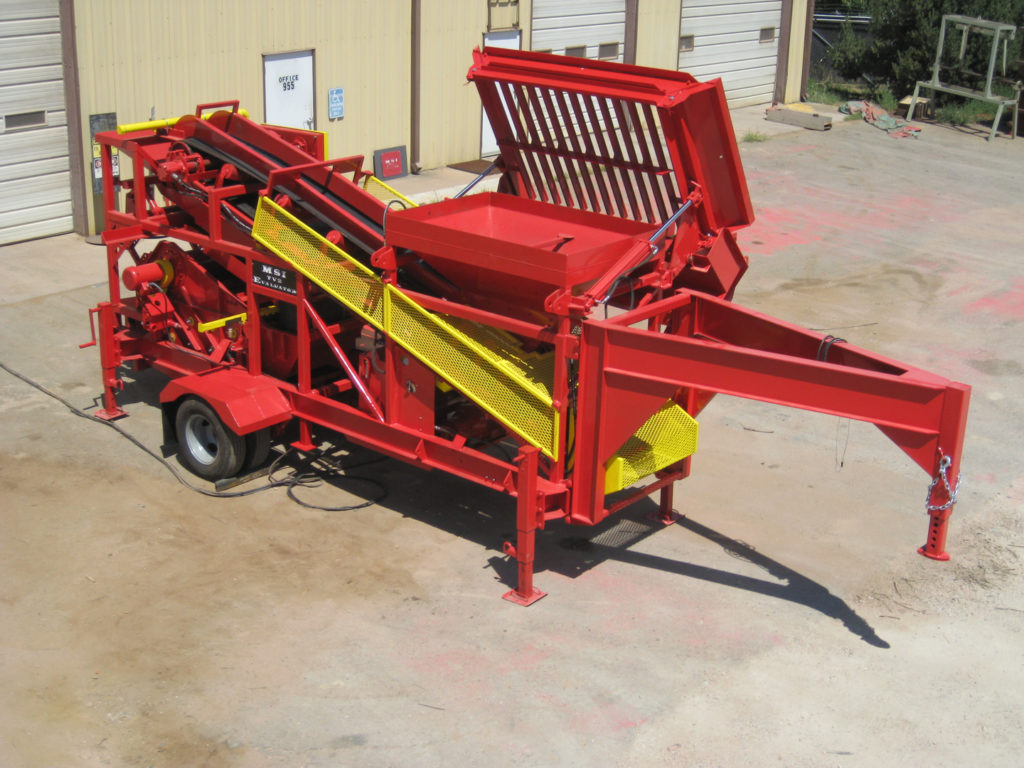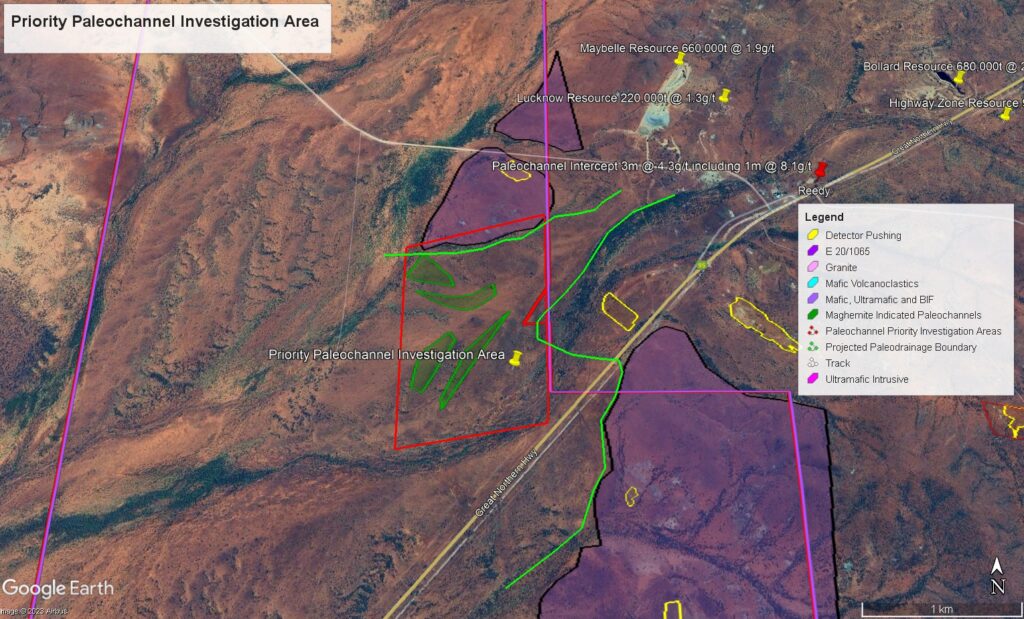reports & New Programs
NEW EXPLORATION LICENCE
WESTERN AUSTRALIA’S TUCKANARRA GOLDFIELD.
In July 2023 we were indeed very fortunate to be able to apply for a new exploration licence north of Cue, WA. The Mining Registrar has approved our application and recommended it be granted. We now await the normal Native Title process.
This large licence area has been the focus of our attention for some time as it potentially sits south west and over the drainage and hard rock extensions of both the close by Tuckanarra and Reedy goldfields. This ( by comparison) very large area covers some 13 sections and is roughly 10 km’s north to south and 5 kms east west at its widest.
Odyssey Minerals (our neighbour) have just announced, 2 August 2023, reserves of some 325,000 oz au. Their tenements are next door and we are downstream of their areas.
In addition we recently drilled (PGL drill rig) a prospect virtually bordering on our southern boundary and found fine gold in every dish sampled – June 2023. This was not our project however we carried out the drilling survey at Paleogold cost as we had access to a tenement that was directly south of the licence we finally were able to apply for. Further, we completed a radar survey on a mining licence on the NE boundary of our licence area, concentrated on hard rock. So we have had valuable experience very close by.
Why this Exploration Licence?
- Geographically very large exploration licence covering downstream of major region goldfield. Strategic positioning.
- Adjacent (next door and essentially part of) to emerging rediscovered high grade Tuckanarra goldfield. 325,000 ounces announced last month.
- Area previously held by two time WA Prospector of the Year who is now concentrating on base metal projects.
- Significant potential for paleochannel deposits downstream of Tuckanarra – Reedy’s Goldfield- drill hole upstream of 20/1065 that showed 4m @ around 4g/t with 1m @8g/t. 8km upstream from our boundary. Significant.
- The Tuckanarragold field lies within the prolific West Australian Murchison goldfield region.
- The contact between the granite and surrounding greenstone is sheared and is considered prospective for gold mineralisation.
- Acquisition of geological and magnetic data has highlighted the position of the contact. By enhancing maghemite which is inferred to be within the paleo channels, the targets are up 700m long and may represent auriferous paleo-drainages. Paleo-drainage Targets
- Little work since 1990. No modern exploration.
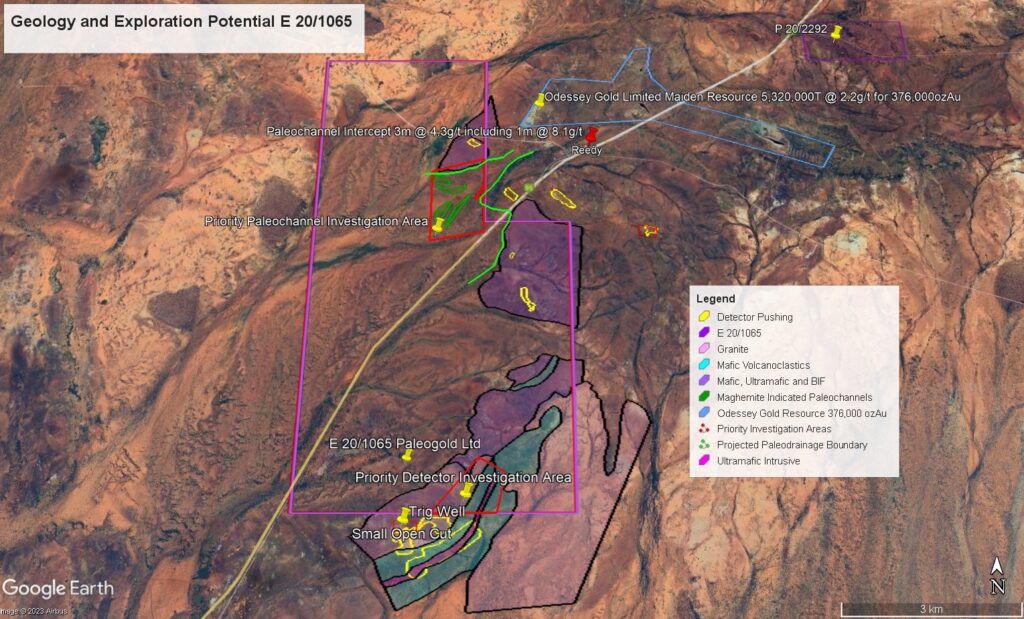
Planned work program:
Program will have three pathways – all running at the same time.
- Ground penetrating RADAR program.
- Survey across anticipated extensions of known paleochannel intercepts.
- Extend that survey with analysis of graphic results – see graphic.
- Radar survey hard rock potential ore bodies – again that extend into 1065.
- Professional metal detector survey – locating close to surface concentrations of gold – numerous identified areas over 10 km strike – followed by radar surveys then auger drilling, bulk testing with PGL processing plant. Consideration high tonnage bulk close to surface mining – potentially utilising mechanised roadwork type scrapers.
- Utilising latest technology metal detectors to find concentrations of small nuggets that can signify an ore body hidden by alluvial cover, followed by close grid radar survey to direct PGL drill rig targets and assay results.
- Intense study of all results and how they impact the overall selection of new targets.
- Ground proof, plot hard rock targets – radar survey at earliest.
First radar survey plotted – attempt to intercept recorded high-grade paleochannel.
Priority Targets.
In the north a significant ovoid shape granite dome lies within the tenure and immediately south of the Tuckanarra Gold centre. The contact between the granite and surrounding greenstone is sheared and is considered prospective for gold mineralisation. Acquisition of geological and magnetic data has highlighted the position of the contact. Acquired processed magnetics have highlighted potential paleo-drainages within the top portion of the tenure.
Note: Significant potential for paleochannel deposits downstream of Tuckanarra – Reedy’s goldfield. Note drill hole upstream of 20/1065 that showed 4m @ around 4g/t with 1m @8g/t. 1.8km from our boundary.
Review of exploration on neighbouring tenements E20/783, P20/2417 and P20/2418 (acquired data and Open File) has highlighted the potential for gold in paleo-drainages. The main drainage system that drains the Tuckanarra Gold Mining centre passes onto E20/1065. Detail airborne magnetics (unfiltered) has outlined a series of old paleo-drainages (not a part of the current drainage system) by enhancing maghemite which is inferred to be within the paleo channels. The targets are up 700m long and may represent auriferous paleo-drainages. Paleo-drainage Targets.
Location: Our new Tuckanarra Project lies 30km NNE of the town of Cue in the Murchison Goldfield. E20/1065 straddles the Great Northern Highway and lies immediately south of the historic gold mining centre of Tuckanarra.

The new Tuckanarra Project is considered very prospective for gold mineralisation. Large areas of detector pushing on Mafic volcanics to south of the licence lease. This structural rock unit extends into E 20/1065 and must also be prospective for gold using detectors to plot gold concentrations followed by radar to pinpoint targets, all enabling potential bulk processing of any commercial concentrations.
Note – the zone within our licence has not been treated and potentially the source of the gold in the very large detector mechanised pushing area on the neighbouring tenement to the south. – a priority target.
In addition, this same southern section of 20/1065 there is potential for small high grade paleochannels draining from these Mafic volcanics.
The potential exists for hard rock ore bodies on the northeast of the EL where small historical mines can be seen on Google.
All the above are priority targets.
Chiltern Victoria Update.
September 2023
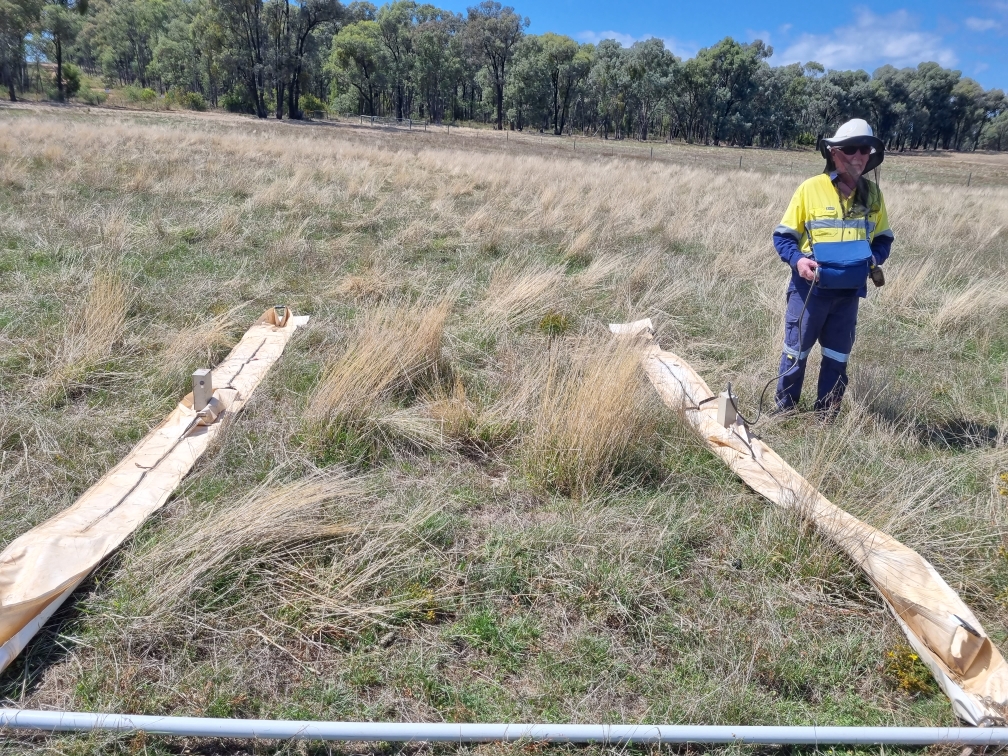
Radar start at Scothmans Lead Chiltern.
Our Chiltern Victoria project covering the highly prospective Scotchman’s Lead area continues. Next steps will, on Vic Mines Dept. approval, involve selected excavation of costeans to open up several sections of the leads to study the potential for gold recovery left behind by the early miners. This can include unmined areas between claims, offshoot small leads, and potentially unmined leads unknown until the radar revealed their presence.
The Chiltern goldfield was extremely rich and historically produced some 27 tons of gold – all in a short time period. It was known at the time as the New Ballarat.
Indeed a very important target for the company. We continue to review this project prior to entering into a JV for the next phase.
The following are excerpts from our Consultant Geologist, Derek Reeves report.
The Chiltern goldfield was a phenomenally rich deep lead field – essentially alluvial gold in deep buried rivers. So rich it was known as the New Ballarat. We will target the shallow feeder channels that deposited that gold.
Over 500,000 ounces (reported) was produced from a small area – all essentially alluvial gold.

A typical radar image.
We have targeted the tributaries that fed these rich deep leads – the source of the gold that made this historic field so famous. We can see via radar very shallow paleochannels that have remained undiscovered until now – with our technology we have located these ancient channels ready for the next step opening up the targets via excavation – shallow depths.
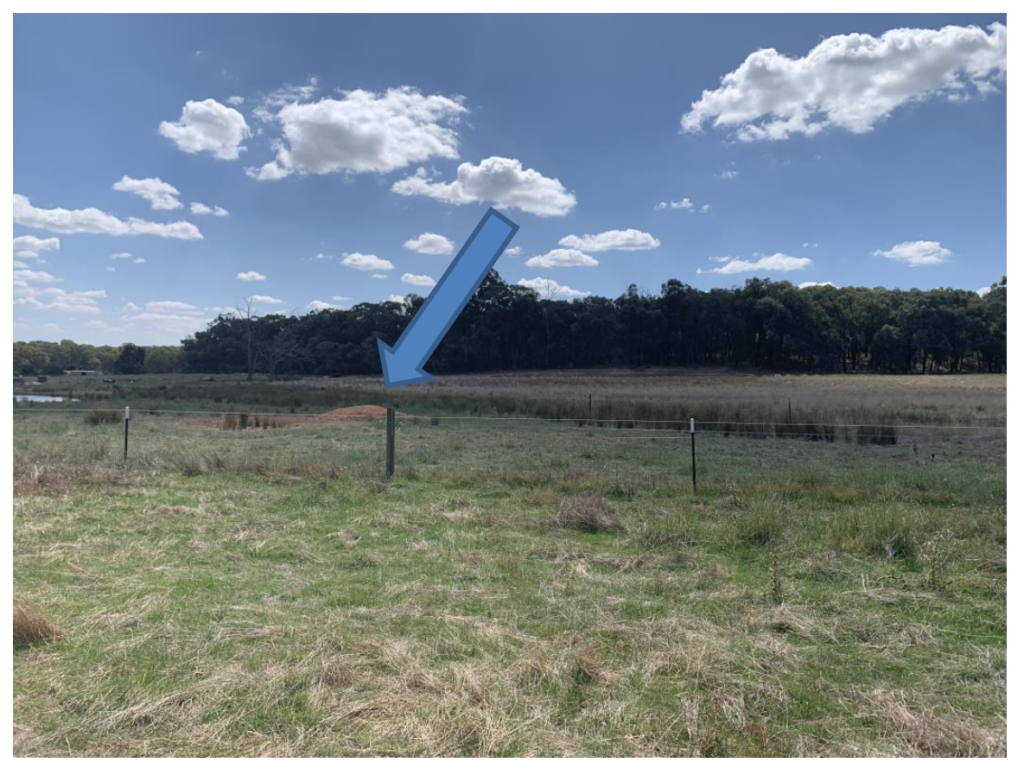
Early miners and explorers had no possible way of locating these gold source channels – now we can do this simply and easily – modern science at work with newly developed next-generation ground penetrating RADAR coupled with state of the art computer modelling gives us the “drill here” accuracy we expect.
This is an exciting new development for the company
Victoria was historically the richest alluvial gold region in the world.
And potentially still carries significant reserves.
Victoria’s alluvial gold made history with discoveries such as Ballarat and Bendigo and Victoria is now is seeing a very successful revival in deeper hard rock exploration deposits which were not known to earlier explorers – new technology has changed that. Deep deposits in new areas are numerous and will keep coming. These are hard rock deposits.
Where you have hard rock deposits there will be alluvial deposition not far away – formed by weathering and erosion of this primary gold mineralisation.
This new gold boom in Victoria is opening up opportunities for our alluvial technology based exploration tools – and PGL will now be part of it. The hard rock explorers are not interested in what we are interested in – all to our advantage.
We see great opportunity in bringing our technology and methodology to Victoria – not just for a focus on the new areas and what that can hold for alluvial gold in paleochannels but most importantly looking at the shallow channels missed by earlier miners. And our Chiltern licence will be the first.
Remember that old goldrushes finished either with a lack of easy gold or a low gold price which stopped many projects in their tracks. This latter cause leaves many untouched areas in Victoria in the one of the world’s greatest alluvial provinces. A no-brainer for a shallow paleochannel explorer -and we are just that and with an exclusive proven technology – methodology.
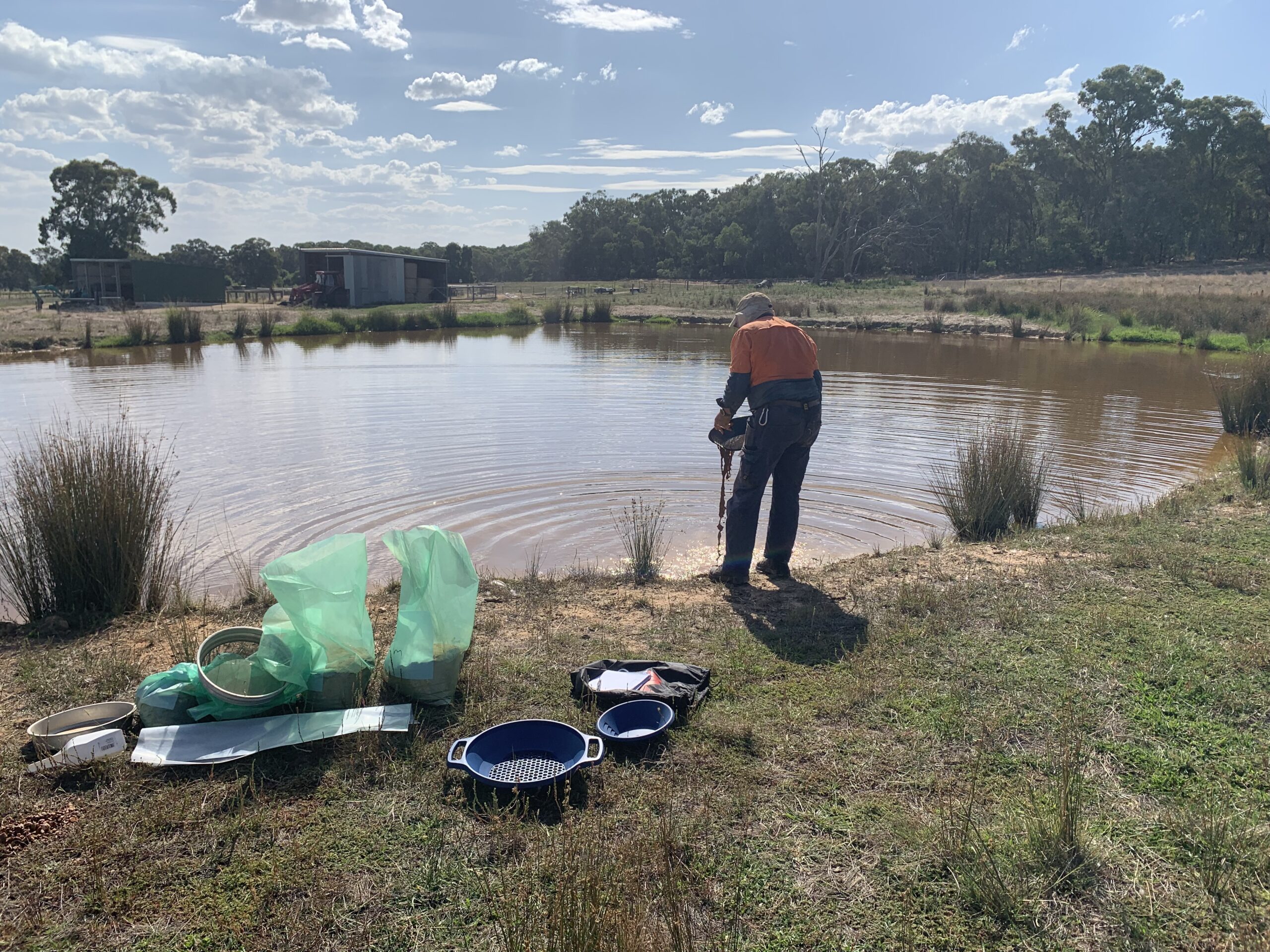
Washing the drill samples at Chiltern.
We know Victoria very well having mined alluvials and shallow paleochannels successfully in the 90’s only ceasing because of the very low gold prices at the time. Not like now with such high gold prices projected to continue for some years.
There are numerous locations in our study area and Chiltern is a first for the Victorian portfolio. Located in an historic ultra-rich deep lead location in an historic goldfield the tenements we are targeting have mostly never been explored for shallow channels.
Great Fingal South Project
We have applied for and have received approval for six POW’s (Program of Works) over six tenements on the outskirts of Cue township that are well known for surface nuggets. Work can commence immediately. POW’s are valid until mid-2027.
The planned program is to utilise dry blowing gold recovery to identify “hot spots” that may be signalling concentrations under cover.
To that end we have an agreement with a local dry blowing expert whose business is full time dry blowing for gold. He has substantial equipment and has been successful for a number of years in the Cue area. His is a large scale high throughput operation.
He is very keen on the areas we have planned and in his words, knows there is surface gold in numerous locations on the tenements.
Our agreement is for a share of gold production plus full GPS reporting of daily recoveries. These locations will be plotted to gradually build a picture of where the gold is, and any concentrations.
Our consultant geologist utilises this technique in some circumstances prior to any radar survey.
We are confident that this project can go some way to solving the puzzle of gold concentrations around Cue and potentially provide some modest gold production.
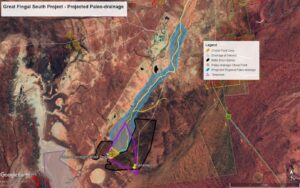
Overview of the Great Fingal South Project Tenement showing Projected Paleo-drainage downstream of Major Historic Mines and Modern Open Cuts.
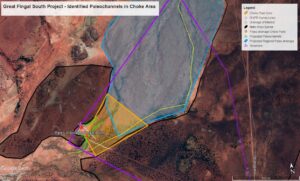
Detail of the Great Fingal South Project showing the DGPR Survey Lines, Projected Paleochannels and the Choke Point.
Paleogold have signed agreements with the tenement holder for complete control & access at our option and control of all alluvial & paleochannel gold recovered.


With our new exploration methodology we have the ability to quickly find ancient river channels. With experience and now available simple technology it will give the company a unique opportunity to find prospective paleochannels and build a portfolio of sites that hitherto have been either ignored, or not understood.
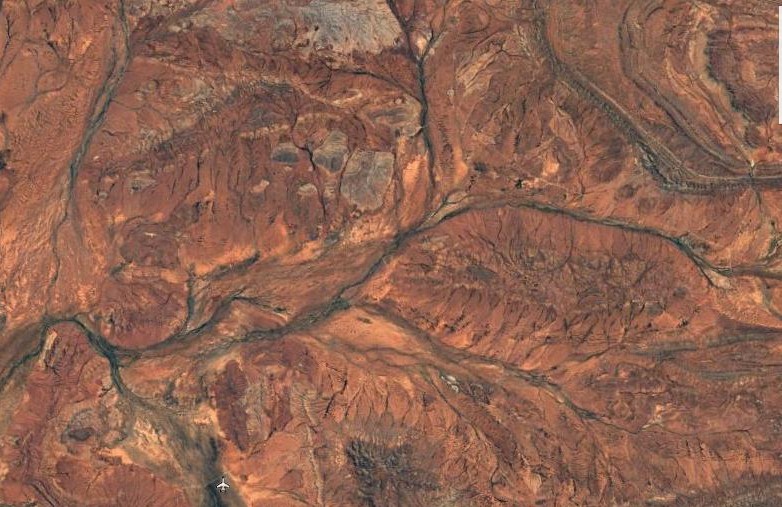
Typical Terrain
The greater region has hosted many small and several very large and historic gold mines. What attracts the company is that several large, now mostly dry water courses drain these areas increasing the potential that buried channels exist either in, or close to the current dry river systems.
OUR RADAR REVEALS THEM IN REAL TIME AND IN GREAT DETAIL, THEN WE DRILL IMMEDIATELY.
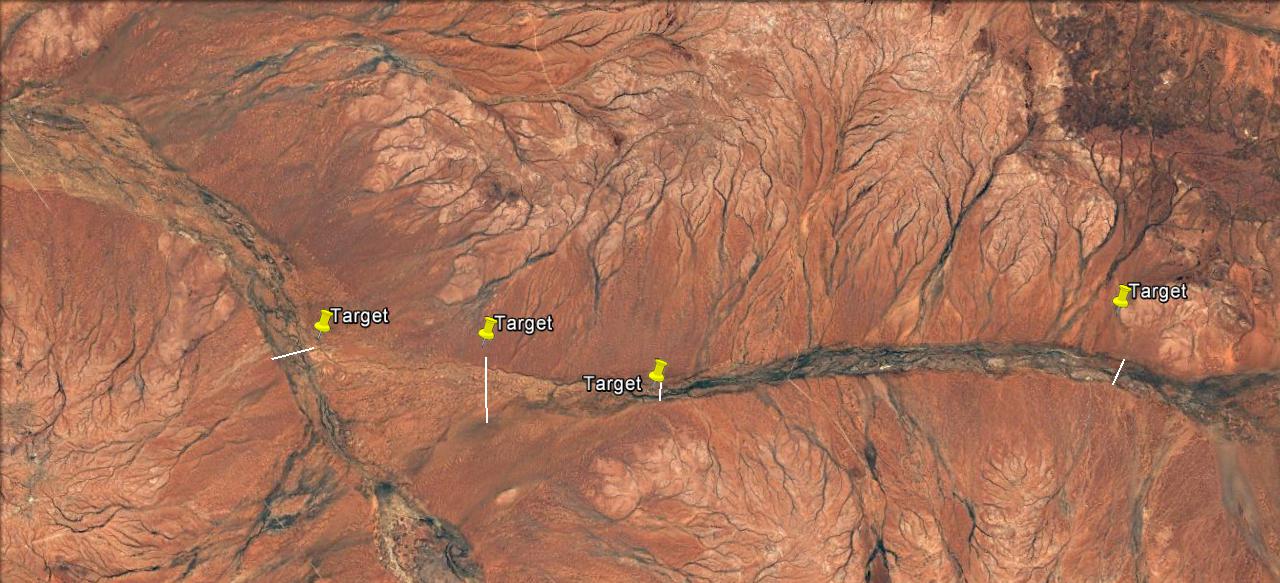
Example of Traverse Plan
As in all cases these now dry river systems shown and those buried drain well-known gold zones.
Paleogold is radar surveying and studying the system which would take any drainage from the known goldfields and massive gold mines. Many gold nugget finds have been reported in the areas where we are surveying and drilling.
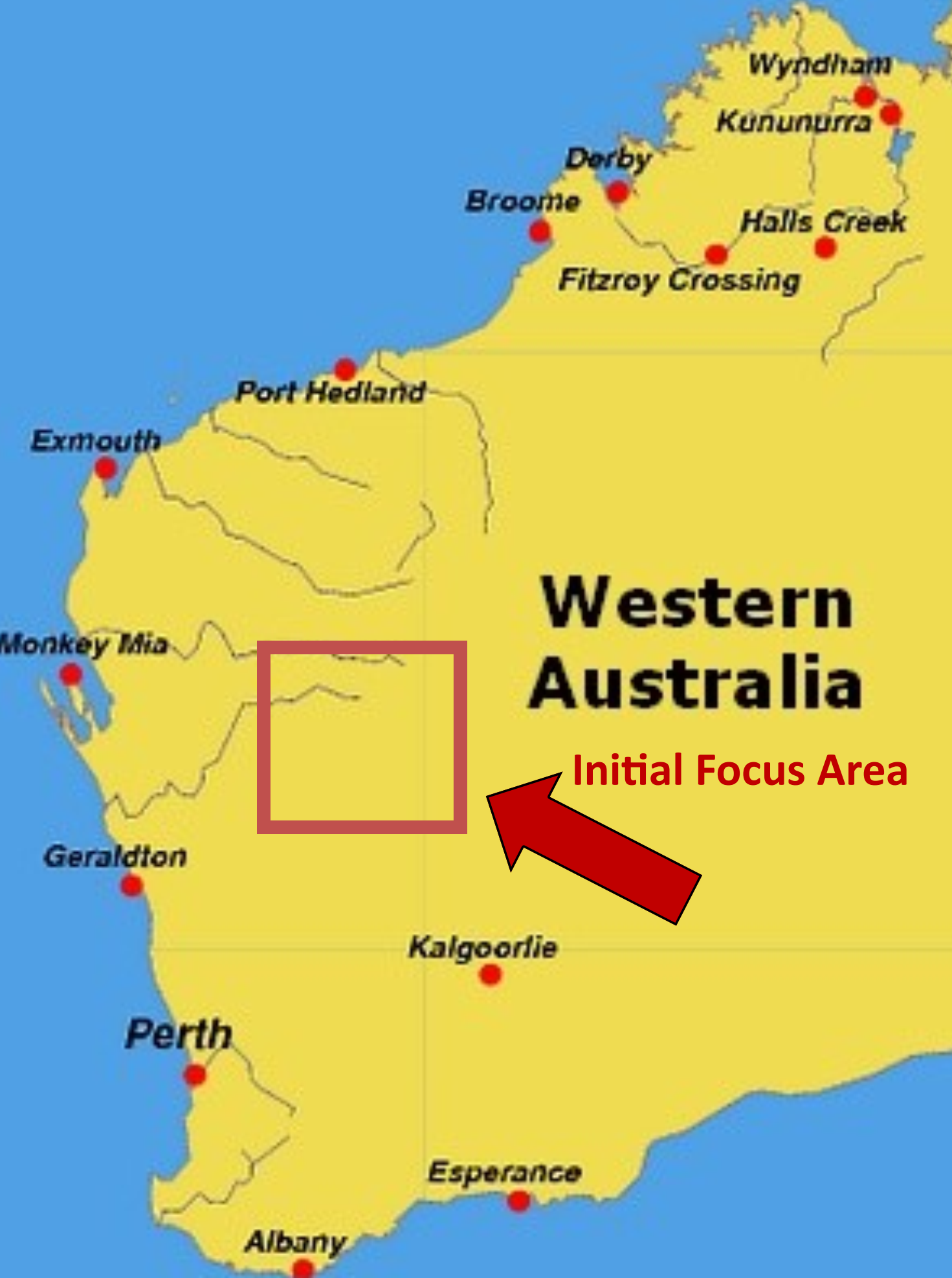
Initial Area of Focus
On success of the survey in delineating paleochannels and demonstrating the Paleogold methodology is sound the company will seek to optimize this position of strength by looking at other similar locations.
The steps to gold production.
All Paleogold survey areas are selected because they demonstrate the ability to provide sites for exploration with view to discovering mineable paleochannels.
The greater region has hosted many small and several very large and historic gold mines. What attracts the company is that several large, now mostly dry water courses drain these areas increasing the potential that buried channels exist either in, or close to the current dry river systems.
Alluvial mining can be very economical as far as plant and equipment is concerned. Water is required however modern equipment does not require the levels of water/per ton of treated wash that was previously the case. Alluvial mining is a relatively simple operation without the use of chemicals and complicated circuits. Water and gravity is all that is needed.
The prospects all have reasonable access and are potentially mineable all year round.
On success of the survey in delineating paleochannels and demonstrating the strength of the Paleogold methodology the company will seek to optimize this position of strength by looking at other similar locations all over Western Australias enormous gold fields – old and new, and indeed expanding the project in the current area of study.
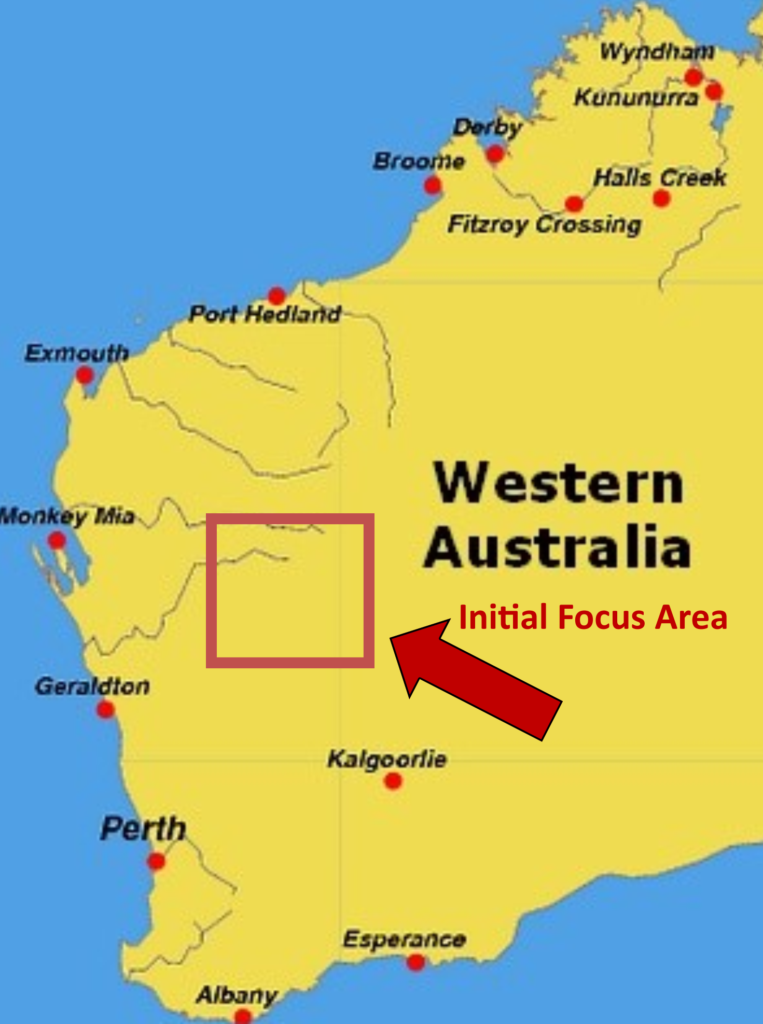
- The first step is to instigate the program and commence, then complete the initial passive seismic survey. The survey will be carried out by the Directors with the assistance of one extra person. It is expected to take three to six weeks, plus another week or two for data processing and final reporting in Perth. Data for each unit can be emailed ahead – this enables next day reports from Perth on results and technical information to assist an understanding of the terrain under the river beds. This can signal a need to quickly alter or amend the survey plan to ensure we get the best possible data.
- On survey success in locating suitable channels we then need to run survey lines upstream and downstream from the initial survey line to better define the potential resource.
- Next stage is the selection of site/sites for physical testing of any revealed channels. The Consulting Geophysicists will assist in this process.
- Permit application stage.
- An excavator will open shallow costeans/trenches to study the profiles of the wash at planned locations, enabling on site analysis along the surveyed channel with panning of selected samples, or utilising a small gravity sampling unit.
- The next stage will be the on-site small production testing utilising a compact pilot alluvial plant. See example photo below of a similar small plant to run bulk tests as production sample testing. This unit would be utilised in future for forward testing of production sites.
- Full production should all the surveys and production testing prove up an economical resource would see the construction of a medium sized alluvial plant. Again a sketch of an envisaged plant is shown below.
Alluvial mining processing plant equipment is simple and very economical.
